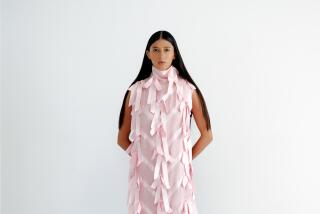From Saris to Mehndi, the Indo-Craze Catches On
Walking through a trendy boutique in a mall in the Valley, I am reminded of when I was a little girl and I wrapped myself in the gold and rich colors of my grandmother’s soft silk saris. I see bright red dots called bindis, not wrapped in little cards in the sweet-smelling Indian shops of my childhood but crowded together in a neon-lit showcase with chokers, cheap jewelry, colorful hair dyes and other trendy accessories.
Flipping through a popular teen magazine, I see a model’s hands delicately painted with mehndi. I see lush Indian fabrics cut into skimpy dresses and worn beneath grunge denim overalls. And I see more and more of my American friends wearing toe rings--just for fun.
It is strange seeing the clothes and styles that I always thought of as so beautiful and unique to my heritage now considered so fashionable and exotic.
I was born in New Jersey and, except for vacations in India, have lived all of my 14 years in the United States. My knowledge of Indian culture comes from my family and their friends. But my name is Indian (after a saint, Mirabai) and so, in many ways, is my way of looking at the world.
In my family, we celebrate the Indian holidays--Diwali, Krishna’s birthday and others--along with Christmas and the Fourth of July. I dress in lungas (long skirts with short waist-length top) or salwar kameezes (long tunic tops worn over loose pants). And for special occasions, my mom, aunts and grandmother wrap saris around their bodies. That makes my memories of bindis, saris and mehndi intensely personal, not from the pages of a fashion magazine.
But it is clear that the Indian influence on American culture--what some prominent trend-watchers call “The Indo-craze”--is growing. From Indian music to books to films to street fashion, all things Indian are suddenly in.
Indian-inspired clothes are chic--and not only in teen magazines like YM and Seventeen, but in Vogue, Elle and Mirabella. Designers are being influenced by Indian prints and designs. I can see the same draping pleats of saris in their clothes. Celebrities such as Goldie Hawn are spicing up their blond looks with mehndi and bindis and heavy kohl makeup under their eyes.
As a young child, I used to be mesmerized by how my grandmother, who was born in India and lived there until she was 24, rolled the red Kum Kum powder between her fingers into a perfect circle and dotted it on her forehead. Sometimes, I would take some of the red powder out of her small silver container and try to roll it myself. Of course, it didn’t work, and I smeared it all over my forehead.
But how I longed to skillfully dot that perfect bindi on my forehead. I kept practicing and practicing on my own and finally I was able to roll the red powder into a tiny ball, and managed to land it in the middle of my forehead. I was 10, and I was so proud. I felt like I had passed one of the important tests to be an Indian woman. I showed it to everybody, beaming with pleasure as some of the adults admitted they couldn’t roll it nearly so well. Then I found out about easy-to-apply liquid Kum Kum and stick-on bindis, which come in round, teardrop and paisley shapes.
My friends used to ask me what that dot on women’s foreheads represented, and I felt ashamed to tell them I had no idea, I always thought it was just a decoration. But when I finally asked my grandmother, she patiently explained it was the symbol for Hinduism and was first used as part of a religious ceremony long ago. Later, I discovered from the Internet that the red powder used by the Hindu priests to bless the foreheads of women and men represented a drop of blood from the demons that the goddess Durga killed. It symbolized the victory of good over evil.
At one time, it also was a symbol worn only by married women, applied during their Hindu marriage ceremony. But that’s not the case anymore, here or in India, where most women and girls wear one. Whatever its origins, to me, the bindi is a symbol of beauty and religion. And, most of all, my heritage.
When I see mehndi-painted hands or feet, I always think of my cousin Sahana. She wore mehndi for her debut performance of Bharatnatayam dancing, which is a form of classical South Indian dance that tells a story through gestures and movement. I saw her whirling around on a stage with her beautiful silk costume and gold jewelry, large gold-colored bells fastened around her ankles. In her palms and on the tops of her feet circles were painted, and the backs of her fingers were stained red--to attract the eye to the dancer’s hands and feet.
Before her wedding, my aunt Sumana had her feet hennaed. She went to a salon in Queens, N.Y., where an Indian woman used a foil cone with henna paste inside (like a cake decorating tube) to draw an intricate design freehand--without any stencils. My aunt had to keep the mehndi paste on for five hours and went home with plastic bags on her feet. But her designs lasted for three weeks after her wedding.
When I was 7, I used to sit in my room with my red marker and color my feet and hands pretending I was a dancer. I showed my stained hands and feet to my mom, who didn’t get upset because it was washable.
Just a month ago, I had my hands hennaed with real henna for the first time. The dye came in a little plastic tube with a pointed screw-on top to make thin lines. I asked my friend who is an artist to make a design and apply it onto my hands. I was nervous at first, and so was he because he had never done this before, but it turned out beautifully. It took 45 minutes to dry, and when it began to peel, I washed it off my hands. The design started off a light orange color, but after a couple of hours it darkened and by the next day, it was a rich brown.
Today, mehndi--a tradition 5,000 years old--is really trendy. A lot of actresses and other celebrities seem to love the look. The actress Liv Tyler had her limbs mehndied in a Vanity Fair article, and actress Demi Moore wears mehndi too.
Gwen Stefani of the rock group No Doubt wears mehndi patterns on her hands or bindis on her forehead. She picked it up from the Indian mother of a boyfriend, she said.
Sometimes, I got mad when I saw the pictures of celebrities using Indian traditions to be fashionable. It seemed to me that they were robbing something valuable from my culture without understanding the meaning of such traditions.
Saris, mehndi and bindi have been a part of Indian women’s lives for thousands of years; they are a part of everyday life for millions of women, my aunts and my grandmother included. I respect those who see the real beauty in these decorations, and now I see that those who make them popular show appreciation for these customs and, in a certain way, honor my heritage.
Whether at the mall or at an important Indian ceremony, these decorations mean so much to me. Not only do they represent beauty, but they stand for a culture that I am very proud to be a part of.






